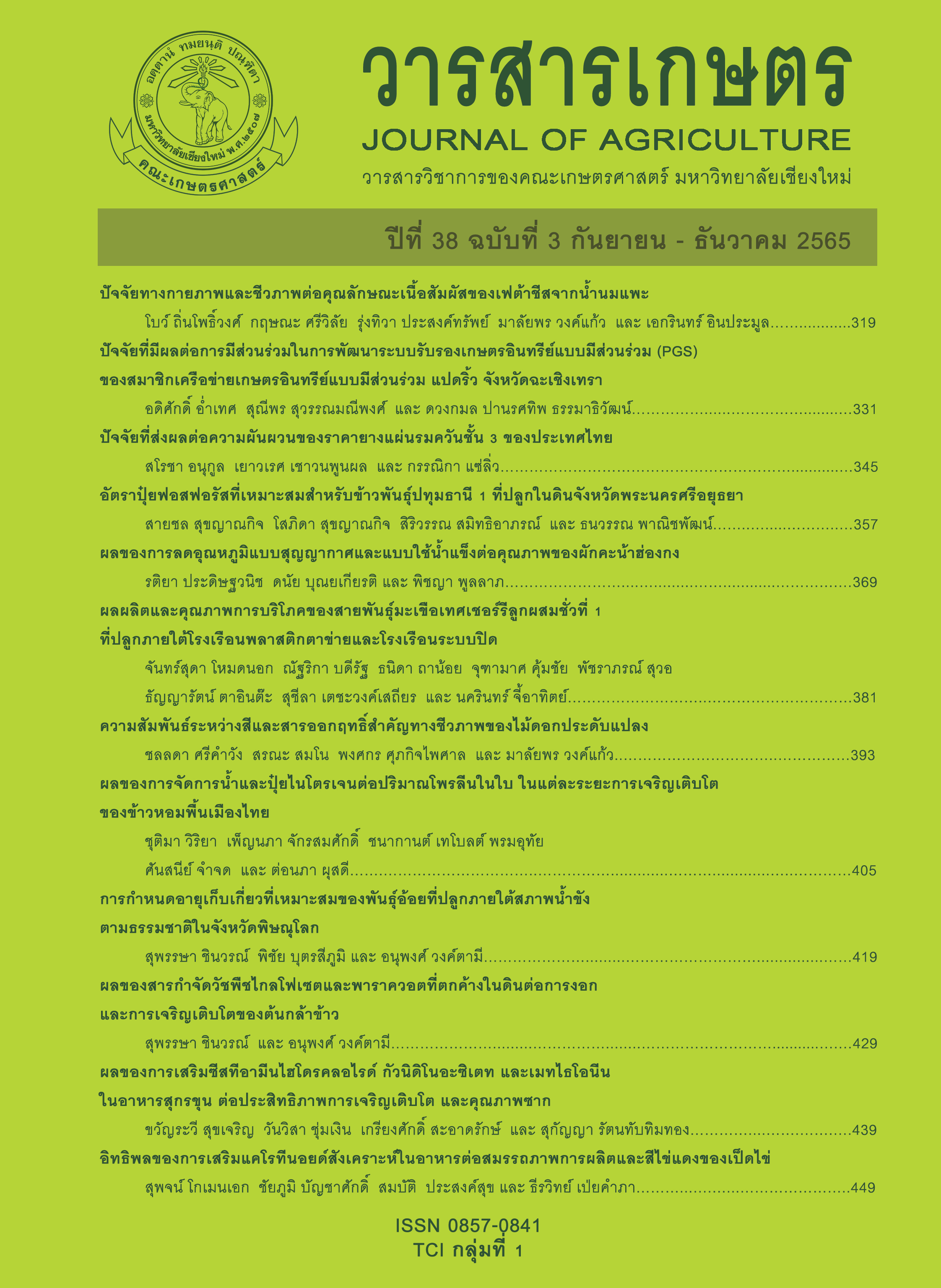Effects of Glyphosate and Paraquat Residues in Soil on Germination and Seedling Growth of Rice
Main Article Content
Abstract
This study evaluated the germination of rice seed under soil contaminated with herbicide, glyphosate and paraquat. Each of the herbicides was arranged in 2 x 5 factorial in CRD with three replications. The first factor was application rates consisting of recommended rate and two times of recommended rate. Glyphosate included 240 and 480 g (ai)/rai while paraquat was 82.6 and 165.6 g (ai)/rai. The second factor was the seeding date at 3, 7, 14, 21 and 28 days after herbicide application. The results showed that the application rate and rice seeding date after spraying both glyphosate and paraquat herbicides affect the percentage of germination, shoot length and root length of rice. Glyphosate and paraquat herbicide application at two times the recommended rate resulted in lower germination percentage, shoot length, and root length of rice than that of the recommended rate. The percentage of germination at 21 days after glyphosate application at both rates increased to 92 % compared to no glyphosate application, while the percentage of germination, shoot length, and root length of rice at 28 days after applying at a rate of 240 g (ai)/rai were the same as with no glyphosate application. For paraquat, seeding at 21 days after both rates of application resulted in the percentage of germination, shoot length and root length being increased to 90 % compared with no paraquat application and tends to increase when the soil is left for longer. This study concluded that the soil should be left at least 21 days after glyphosate and paraquat application at both rates. Seeding before 21 days is not recommended, especially at two times the recommended rate.
Article Details

This work is licensed under a Creative Commons Attribution-NonCommercial-NoDerivatives 4.0 International License.
References
Ahrens, W.H. 1994. Herbicide Handbook. 7th ed. Weed Science Society of America, Lawrence. 352 p.
Amondham, W., P. Parkpian, C. Polprasert, R.D. Delaune and A. Jugsujinda. 2006. Paraquat adsorption, degradation, and remobilization in tropical Soils of Thailand. Journal of Environmental Science and Health 41(5): 485-507.
Aroonsrimorakot, S., V. Sangnate and P. Pradabphetrat. 2017. The chemical application in rice production of farmers in Nong-Sue district, Pathum Thani province. Prawarun Agricultural Journal 14(2): 173-180 (in Thai)
Bandara, J.M.R.S. and P.C. Kearney. 1991. Paraquat residues in lowland rice fields. Journal of Agricultural Sciences 29: 11-19.
Bromilow, R.H. 2004. Paraquat and sustainable agriculture. Pest Management Science 60(4): 340-349.
Davies, W.I.C. and J. Davies. 1981. Varying the time of spraying with paraquat or glyphosate before direct drilling of grass and clover seeds with and without calcium peroxide. Grass and Forage Science 36(1): 65-69.
Egley, G.H. and R.D. Williams. 1978. Glyphosate and paraquat effects on weed seed germination and seedling emergence. Weed Science 26(3): 249-251.
Epa, U. 1993. Re-registration Eligibility Decision (RED): Glyphosate. United States Environmental Protection Agency, Office of Prevention. 291 p.
Gomes, M.P., F.V. da Silva Cruz, E.M. Bicalho, F.V. Borges, M.B. Fonseca, P. Juneau and Q.S. Garcia. 2017. Effects of glyphosate acid and the glyphosate-commercial formulation (Roundup) on Dimorphandra wilsonii seed germination: Interference of seed respiratory metabolism. Environmental Pollution 220: 452-459.
Helander, M., A. Pauna, K. Saikkonen and I. Saloniemi. 2019. Glyphosate residues in soil affect crop plant germination and growth. Scientific Reports 9: 19653, doi: 10.1038/s41598-019-56195-3.
Huang, Y., H. Zhan, P. Bhatt and S. Chen. 2019. Paraquat degradation from contaminated environments: Current achievements and perspectives. Frontiers in Microbiology 10: 1754, doi: 10.3389/fmicb.2019.01754.
ISTA. 2016. International Rules for Seed Testing. The International Seed Testing Association, Zurich. 284 p.
Kwonpongsagoon, S., C. Katasila, P. Kongtip and S. Woskie. 2021. Application intensity and spatial distribution of three major herbicides from agricultural and nonagricultural practices in the central plain of Thailand. International Journal of Environmental Research and Public Health 18(6): 3046, doi: 10.3390/ijerph18063046.
Lee, J.-C., M.-S. Kim, C. Kim, C.-H. Chung, S. Cho, G. Han, K. Yoon and B.-W. Kim. 2003. Removal of paraquat in aqueous suspension of TiO2 in an immersed UV photoreactor. Korean Journal of Chemical Engineering 20(5): 862-868.
Maldani, M., F.Z. Aliyat, S. Cappello, M. Morabito, F. Giarratana, L. Nassiri and J. Ibijbijen. 2021. Effect of glyphosate and paraquat on seed germination, amino acids, photosynthetic pigments and plant morphology of Vicia faba, Phaseolus vulgaris and Sorghum bicolor. Environmental Sustainability 4: 723-733.
Nomura, N.S. and H.W. Hilton. 1977. The adsorption and degradation of glyphosate in five Hawaiian sugarcane soils. Weed Research 17(2): 113-121.
Office of Agricultural Economics. 2022. (online). Available: https://www.oae.go.th/view/1/ตารางแสดงรายละเอียดข้าวนาปี/TH-TH (June 10, 2022). (in Thai)
Puttha, R. and P. Oupkeaw. 2017. Effect of herbicides contaminated soil on seed germination and seedling growth of commercial rice. Khon Kaen Agriculture Journal 45(Suppl. 1): 249-254. (in Thai)
Rice Department. 2012. Sustainable Technology on Upland Rice Cultivation. The Agricultural Co-operative Federation of Thailand, Ltd., Nonthaburi. 116 p. (in Thai)
Sangpakdee, K., K. Silprasit, D. Peangthai, W. Khwaiphan, S. Siriyan and P. Kroeksakul. 2014. A study of chemical use behaviors of farmers in Ongkharak district, Nakhon Nayok province, Thailand. Khon Kaen Agriculture Journal 42(3): 375-384. (in Thai)
Sangruan, P., P. Uayyue and N. Insalud. 2016. Effects of herbicide on seed germination and growth of rice seedling. Agricultural Science Journal 47(Suppl. 2): 709-712. (in Thai)
Vencill, W.K. 2002. Herbicide Handbook. 8th ed. Weed Science Society of America, Lawrence. 493 p.


